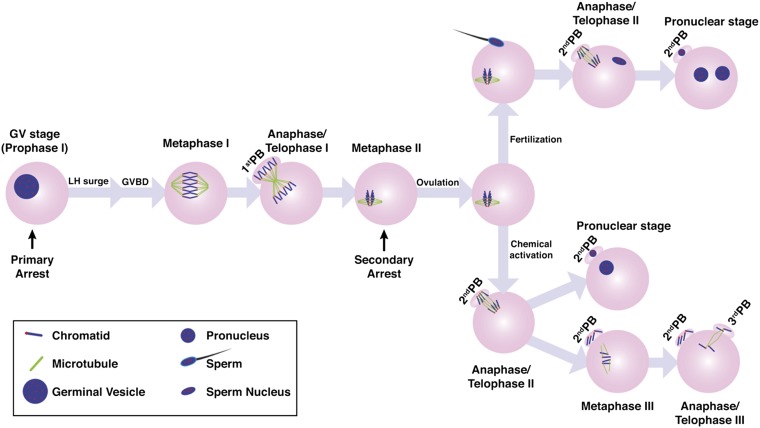Fig. 1.
Meiotic resumption and egg activation in the mouse. Schematic representation of meiotic resumption and egg activation by either fertilization or chemical agents. The stages at which primary (prophase I) and secondary (MII) arrest occur are indicated. Oocytes initiate meiosis during fetal development and enter primary arrest at the diplotene stage of prophase I around the time of birth (not illustrated here). Prophase I arrest is maintained during oocyte growth and differentiation. Prior to ovulation, meiosis resumes, the nuclear envelope of the germinal vesicle (GV) dissassembles [GV breakdown (GVBD)], and chromosomes condense and align on the first metaphase plate. During the first division, homologous chromosomes segregate and the first polar body (PB) is extruded (first PB in anaphase/telophase I). The remaining chromosomes realign on the second metaphase plate (MII) followed by secondary arrest. During MII arrest, the first PB often degrades. Eggs that are ovulated can exit MII arrest and complete meiosis when activated by a fertilizing sperm (upper right) or chemical agents, such as SrCl2 or ethanol (lower right), which induce a spike (ethanol) or oscillations (sperm and SrCl2) in cytoplasmic Ca2+ levels and suppress MAPK and MPF activities. On activation, sister chromatids segregate, and the second PB is extruded (second PB in anaphase/telophase II). The activated egg then progresses to pronuclear stage as the nuclear envelope reforms. On chemical activation, the egg can alternatively progress to metaphase III, segregate the remaining chromatids randomly during anaphase III, and extrude a third PB (anaphase/telophase III).

